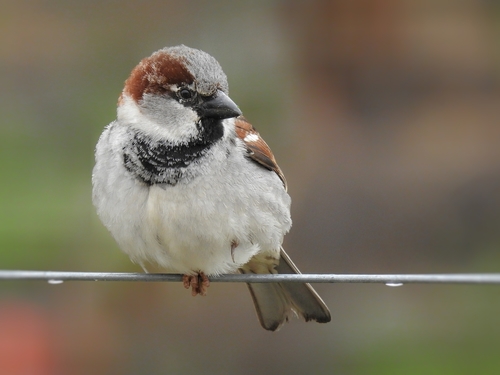
House Sparrow
The House Sparrow (Passer domesticus) is one of the most widespread and recognizable birds globally. Originally native to Eurasia and North Africa, it has followed human settlements to nearly every corner of the world, making it a ubiquitous presence in urban and rural environments alike. Its adaptability and close association with humans have allowed it to thrive, often outcompeting native species. Ecologically, the House Sparrow plays a role in seed dispersal and insect control, although its impact can be complex and context-dependent. While not particularly revered in folklore, its sheer familiarity has made it a subject of numerous studies on avian behavior and adaptation.
14-18 cm
Length
19-25 cm
Wingspan
Least Concern
Conservation Status
Distribution
Native to Eurasia and North Africa. Introduced and established in North and South America, sub-Saharan Africa, Australia, and New Zealand. Generally non-migratory, although some populations in higher altitudes or latitudes may move shorter distances in winter.
Lifespan
Typically 3-5 years in the wild, but can live longer in captivity (up to 10+ years).
House Sparrow's Habitat
Habitat Types
Urban areas, Suburban areas, Agricultural lands, Rural villages
Climate Zones
Temperate, Tropical, Subtropical, Arid
Adaptations
Highly adaptable to human-modified environments. Can utilize a wide range of food sources and nesting sites, including buildings, crevices, and nest boxes. Tolerant of a broad range of temperatures and climatic conditions.
Variations
Numerous subspecies (around 12) are recognized, differing subtly in plumage coloration and size. These variations are often linked to local climate and environmental conditions.
Appearance
Breeding Plumage
Males have a distinctive black bib, grey crown, and chestnut nape during the breeding season. Females and non-breeding males are duller, with streaked brown upperparts and greyish-buff underparts.
Seasonal Feather Changes
The black bib on breeding males becomes more prominent and sharply defined during the breeding season. After breeding, the plumage becomes slightly duller and less contrasting.
Sex Based Plumage Differences
Significant. Males have distinct black, grey, and chestnut markings, while females are predominantly brown and buff.
Notable Features
Stout, conical bill adapted for seed-cracking., Short, rounded wings., Black bib (males only).
Diet and Feeding
Primary Foods
Seeds, Grains, Insects (especially during breeding season), Food scraps
Foraging Behavior
Forages primarily on the ground, hopping and pecking. Often feeds in flocks, especially outside the breeding season. Readily takes food from bird feeders and scavenges human food waste.
Specializations
Strong, conical bill adapted for cracking seeds. Agile and opportunistic, able to exploit a variety of food sources.
Seasonal Diet Variations
Diet shifts to include more insects during the breeding season to provide protein for growing chicks. Relies more heavily on seeds and grains during the winter.
Behavior
Social Structure
Highly social, often forming flocks outside the breeding season. Breeding pairs are territorial, but may nest in loose colonies.
Communication
Variety of chirps and calls., Males use a distinctive 'cheep' call to attract females., Alarm calls alert the flock to danger.
Migration
Generally non-migratory, but some populations in colder regions may move short distances to find food and shelter in winter.
Territorial or Group Behaviors
Males defend a small territory around the nest site during the breeding season. Outside the breeding season, forms large flocks for foraging and roosting.
Conservation
Threats
Habitat loss (loss of nesting sites and foraging areas), Pesticide use (reducing insect prey), Competition with other species, Predation (by cats, birds of prey)
Protection Programs
General wildlife protection laws, Promotion of bird-friendly gardening practices
Local National Laws
Varies by country, but generally not specifically protected due to its abundance. In some areas, considered an agricultural pest.
Population Trend
While still abundant globally, populations have declined significantly in some regions, particularly in parts of Europe.
Population Estimates
Global population estimated to be in the hundreds of millions, possibly over a billion.
Interesting Facts
House Sparrows are not native to North America.
They were introduced to Brooklyn, New York, in the 1850s and have since spread across the continent.
They can swim underwater.
Although rare, House Sparrows have been observed swimming underwater to escape predators.
House Sparrows often take dust baths.
This helps to maintain their plumage by removing parasites and excess oil.
They are highly adaptable to urban environments.
They have learned to exploit human resources, including buildings for nesting and food scraps for sustenance.
Faqs about House Sparrow
Why are House Sparrows declining in some areas?
Several factors contribute to declines, including habitat loss, pesticide use, and increased competition with other bird species.
What can I do to help House Sparrows?
Provide food and water sources, create bird-friendly gardens with native plants, and avoid using pesticides.
Are House Sparrows aggressive towards other birds?
They can be aggressive, particularly around nesting sites and food sources, and may outcompete native birds for resources.
Do House Sparrows mate for life?
While they may form pair bonds for a breeding season, they don't necessarily mate for life and may have different partners in subsequent years.
How can I tell the difference between a male and female House Sparrow?
Males have a black bib, grey crown, and chestnut nape, while females are duller brown and buff overall.
Copyright @ Nature Style Limited. All Rights Reserved.
 English
English